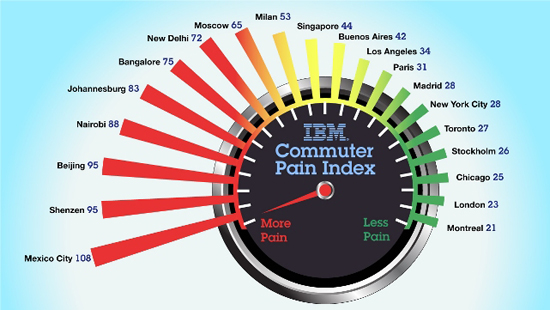Commutes Get Easier Around the World, but IBM Finds Plenty of Pain
<p>The annual Commuter Pain study from IBM, which looks at commutes in 20 cities across the globe, finds that public transit use is up and traffic is somewhat down, but commuters are still highly stressed out about their daily grinds.</p>

No one likes a long (or even a short) work commute; that much is globally true. But what does it mean when even as commutes around the world get less logjammed, drivers continue to build up a head of steam?
The annual IBM Global Commuter Pain survey, released this morning, finds plenty of pain to go around in 20 cities around the world -- even though significant numbers of the 8,042 commuters surveyed said that the amount of traffic has decreased "somewhat" or "significantly" in the past three years.
In fact, 69 percent of respondents said that traffic has negatively affected their health in some way. That's a lot of potential rage on the roads.
Here are the relevant rankings, from worst to best, in the 2011 Commuter Pain survey:
- Mexico City: 108
- Shenzhen: 95
- Beijing: 95
- Nairobi: 88
- Johannesburg: 83
- Bangalore: 75
- New: Delhi: 72
- Moscow: 65
- Milan: 53
- Singapore: 44
- Buenos Aires: 42
- Los Angeles: 34
- Paris: 31
- Madrid: 28
- New York City: 28
- Toronto: 27
- Stockholm: 26
- Chicago: 25
- London: 23
- Montreal: 21
Scores are made of up 10 issues, including commuting time, time stuck in traffic, stress and anger caused by traffic and people deciding not to make a trip due to traffic.
Among the signs of hope -- despite the potential menace of road rage on the world's highways and byways -- are the fact that this year's survey reveals a noticeable trend in people carpooling more and using more public transportation.
Of the roughly one-third of respondents who said they've changed how they commute in the past year, 45 percent said they now take public transit; in Nairobi, Kenya, 70 percent of residents have increased their public transit ridership in the last year. And in New York City, the number of commuters in the metropolitan region who say they drive alone to work has dropped from 90 percent in 2010 to 59 percent in 2011.
The biggest driver in these trends -- and the biggest driver in IBM's motivation for this survey -- is that countries are investing in infrastructure to help smooth commutes.
IBM, of course, sees smarter mobility as one of the key elements of its Smarter Planet initiative (and smarter vehicles, connected to buildings and the grid, is critical to the growth of VERGE), and countries making multi-million dollar investments in traffic controls and public transit opens the door to big opportunities for Big Blue.
In Stockholm, Sweden, for example, IBM put its Congestion Charging System to work on reducing traffic jams by raising tolls as needed. The impacts for drivers, governments and the environment are all significant. As we reported in 2009:
The system, which was launched in August 2007 after a six-month pilot project in 2006, has resulted in overall traffic reductions of 18 percent in the capital.
As a result, the city's emissions due to traffic has dropped by at least 14 percent, and Stockholm is collecting 573 million Krona (about US$84 million) per year in fees, all of which will be directed toward road infrastructure improvements.
The full 2011 Commuter Pain Survey is available for download from IBM.

Delhi traffic jam photo CC-licensed by Lingaraj G J.





